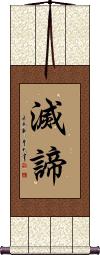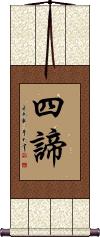Many custom options...
And formats...

Nirodha in Chinese / Japanese...
Buy a Nirodha calligraphy wall scroll here!
Personalize your custom “Nirodha” project by clicking the button next to your favorite “Nirodha” title below...
Four Noble Truths: Elimination of Desire or Attachment
Nirodha
滅諦 suggests that once you eliminate desire or attachment to worldly things, only then can you achieve enlightenment.
Realize that things are impermanent. That fancy car, beautiful spouse, big house, and impressive career are things you can't take with you. These things are a flash in the pan compared to the infinite span of history, generations to come, time, and space.
This term is exclusively used by devout Buddhists. It is not a common term, and is remains an unknown concept to most Japanese, Korean, and Chinese people.
See Also: Buddhism | Enlightenment
Four Noble Truths (Full List)
苦諦集諦滅諦道諦 is the list of tenets of the Four Noble Truths as taught in virtually all sects of Buddhism.
They are suffering (dukkha), desire/attachment (samudaya), release from desire/attachment (nirodha), and the path leading away from suffering (magga).
Four Noble Truths (Buddhism)
四諦 is the title of the Four Noble Truths as taught in virtually all sects of Buddhism.
These truths are suffering (dukkha), desire/attachment (samudaya), release from desire/attachment (nirodha), and the path leading away from suffering (magga).
The suggestion behind these truths is that all things in nature suffer. All things in nature have desire and attachment for things in the physical world. The enlightened can release themselves from the bonds of desire and attachment. And finally, once they release all desire and attachment, the enlightened will find a path that leads away from suffering.
This term is exclusively used by devout Buddhists. It is not a common term, and is remains an unknown concept to most Japanese, Chinese, and Korean people.
See Also: Buddhism | Enlightenment
Not the results for nirodha that you were looking for?
Below are some entries from our dictionary that may match your nirodha search...
| Characters If shown, 2nd row is Simp. Chinese |
Pronunciation Romanization |
Simple Dictionary Definition |
四諦 四谛 see styles |
sì dì si4 di4 ssu ti shitai したい |
More info & calligraphy: Four Noble Truths (Buddhism){Buddh} (See 苦集滅道) The Four Noble Truths catvāri-ārya-satyāni; 四聖諦; 四眞諦. The four dogmas, or noble truths, the primary and fundamental doctrines of Śākyamuni, said to approximate to the form of medical diagnosis. They are pain or 'suffering, its cause, its ending, the way thereto; that existence is suffering, that human passion (taṇhā, 欲 desire) is the cause of continued suffering, that by the destruction of human passion existence may be brought to an end; that by a life of holiness the destruction of human passion may be attained'. Childers. The four are 苦, 聚 (or 集), 滅, and 道諦, i. e. duḥkha 豆佉, samudaya 三牟提耶, nirodha 尼棲陀, and mārga 末加. Eitel interprets them (1) 'that 'misery' is a necessary attribute of sentient existence'; (2) that 'the 'accumulation' of misery is caused by the passions'; (3) that 'the 'extinction' of passion is possible; (4) mārga is 'the doctrine of the 'path' that leads to the extinction of passion'. (1) 苦 suffering is the lot of the 六趣 six states of existence; (2) 集 is the aggregation (or exacerbation) of suffering by reason of the passions; (3) 滅 is nirvana, the extinction of desire and its consequences, and the leaving of the sufferings of mortality as void and extinct; (4) 道 is the way of such extinction, i. e. the 八正道 eightfold correct way. The first two are considered to be related to this life, the last two to 出世間 a life outside or apart from the world. The four are described as the fundamental doctrines first preached to his five former ascetic companions. Those who accepted these truths were in the stage of śrāvaka. There is much dispute as to the meaning of 滅 'extinction' as to whether it means extinction of suffering, of passion, or of existence. The Nirvana Sutra 18 says that whoever accepts the four dogmas will put an end to births and deaths 若能見四諦則得斷生死 which does not of necessity mean the termination of existence but that of continued transmigration. v. 滅. |
滅諦 灭谛 see styles |
miè dì mie4 di4 mieh ti mettai めったい |
More info & calligraphy: Four Noble Truths: Elimination of Desire or Attachmentnirodha-āryasatya, the third of the four dogmas, the extinction of suffering, which is rooted in reincarnation, v. 四諦. |
滅 灭 see styles |
miè mie4 mieh metsu |
to extinguish or put out; to go out (of a fire etc); to exterminate or wipe out; to drown Extinguish, exterminate, destroy; a tr. of nirodha, suppression, annihilation; of nirvāṇa, blown out, extinguished, dead, perfect rest, highest felicity, etc.; and of nivṛtti, cessation, disappearance. nirodha is the third of the four axioms: 苦, 集, 滅, 道 pain, its focussing, its cessation (or cure), the way of such cure. Various ideas are expressed as to the meaning of 滅, i.e. annihilation or extinction of existence; or of rebirth and mortal existence; or of the passions as the cause of pain; and it is the two latter views which generally prevail; cf. M017574 10 strokes. |
滅智 灭智 see styles |
miè zhì mie4 zhi4 mieh chih metchi |
The knowledge, or wisdom, of the third axiom, nirodha or the extinction of suffering. |
滅業 灭业 see styles |
miè yè mie4 ye4 mieh yeh metsugō |
The work or karma of nirodha, the karma resulting from the extinction of suffering, i.e. nirvāṇa. |
滅道 灭道 see styles |
miè dào mie4 dao4 mieh tao metsudou / metsudo めつどう |
{Buddh} (See 道諦,滅諦) truths of the cessation of suffering and of the way to the cessation of suffering Extinction of suffering and the way of extinction, nirodha and mārga; v. supra. |
尼樓陀 尼楼陀 see styles |
ní lóu tuó ni2 lou2 tuo2 ni lou t`o ni lou to nirōda |
nirodha, restraint, suppression, cessation, annihilation, tr. by 滅 extinction, the third of the four dogmas 四諦; with the breaking of the chain of karma there is left no further bond to reincarnation. Used in Anupūrva-nirodha, or 'successive terminaīons', i. e. nine successive stages of dhyāna. Cf. 尼彌留陀. |
無爲法 无为法 see styles |
wú wéi fǎ wu2 wei2 fa3 wu wei fa mui hō |
asaṃskṛta dharmas, anything not subject to cause, condition, or dependence; out of time, eternal, inactive, supra-mundane. Sarvāstivādins enumerate three: ākāśa, space or ether; pratisaṃhyā-nirodha, conscious cessation of the contamination of the passions; apratisaṃhyā-nirodha, unconscious or effortless cessation. |
尼彌留陀 尼弥留陀 see styles |
ní mí liú tuó ni2 mi2 liu2 tuo2 ni mi liu t`o ni mi liu to nimiruda |
nirodha, tr. as 滅 extinction, annihilation, cessation, the third of the four noble truths, cf. 尼樓陀. |
苦集滅道 苦集灭道 see styles |
kǔ jí miè dào ku3 ji2 mie4 dao4 k`u chi mieh tao ku chi mieh tao kujuumetsudou; kujumetsudou; kushumetsudou / kujumetsudo; kujumetsudo; kushumetsudo くじゅうめつどう; くじゅめつどう; くしゅめつどう |
the Four Noble Truths (Budd.), namely: all life is suffering 苦[ku3], the cause of suffering is desire 集[ji2], emancipation comes only by eliminating passions 滅|灭[mie4], the way 道[dao4] to emancipation is the Eight-fold Noble Way 八正道[ba1 zheng4 dao4]; also called 四諦|四谛[si4 di4] {Buddh} (See 四諦) Suffering, Source of Suffering Desire, The Cessation of Suffering, The Way Leading to the Cessation of Suffering (The Four Noble Truths of Buddhism) The four axioms or truths: i. e. duḥkha, pain; samudaya, as above; nirodha, the extinguishing of pain and reincarnation; mārga, the way to such extinction; cf. 四諦. |
The following table may be helpful for those studying Chinese or Japanese...
| Title | Characters | Romaji (Romanized Japanese) | Various forms of Romanized Chinese | |
| Four Noble Truths: Elimination of Desire or Attachment | 滅諦 灭谛 | mettai | miè dì / mie4 di4 / mie di / miedi | mieh ti / miehti |
| Four Noble Truths (Full List) | 苦諦集諦滅諦道諦 苦谛集谛灭谛道谛 | kutai jittai mettai doutai kutaijittaimettaidoutai kutai jittai mettai dotai | kǔ dì jí dì miè dì dào dì ku3 di4 ji2 di4 mie4 di4 dao4 di4 ku di ji di mie di dao di kudijidimiedidaodi | k`u ti chi ti mieh ti tao ti kutichitimiehtitaoti ku ti chi ti mieh ti tao ti |
| Four Noble Truths (Buddhism) | 四諦 四谛 | shitai | sì dì / si4 di4 / si di / sidi | ssu ti / ssuti |
| In some entries above you will see that characters have different versions above and below a line. In these cases, the characters above the line are Traditional Chinese, while the ones below are Simplified Chinese. | ||||
Successful Chinese Character and Japanese Kanji calligraphy searches within the last few hours...






